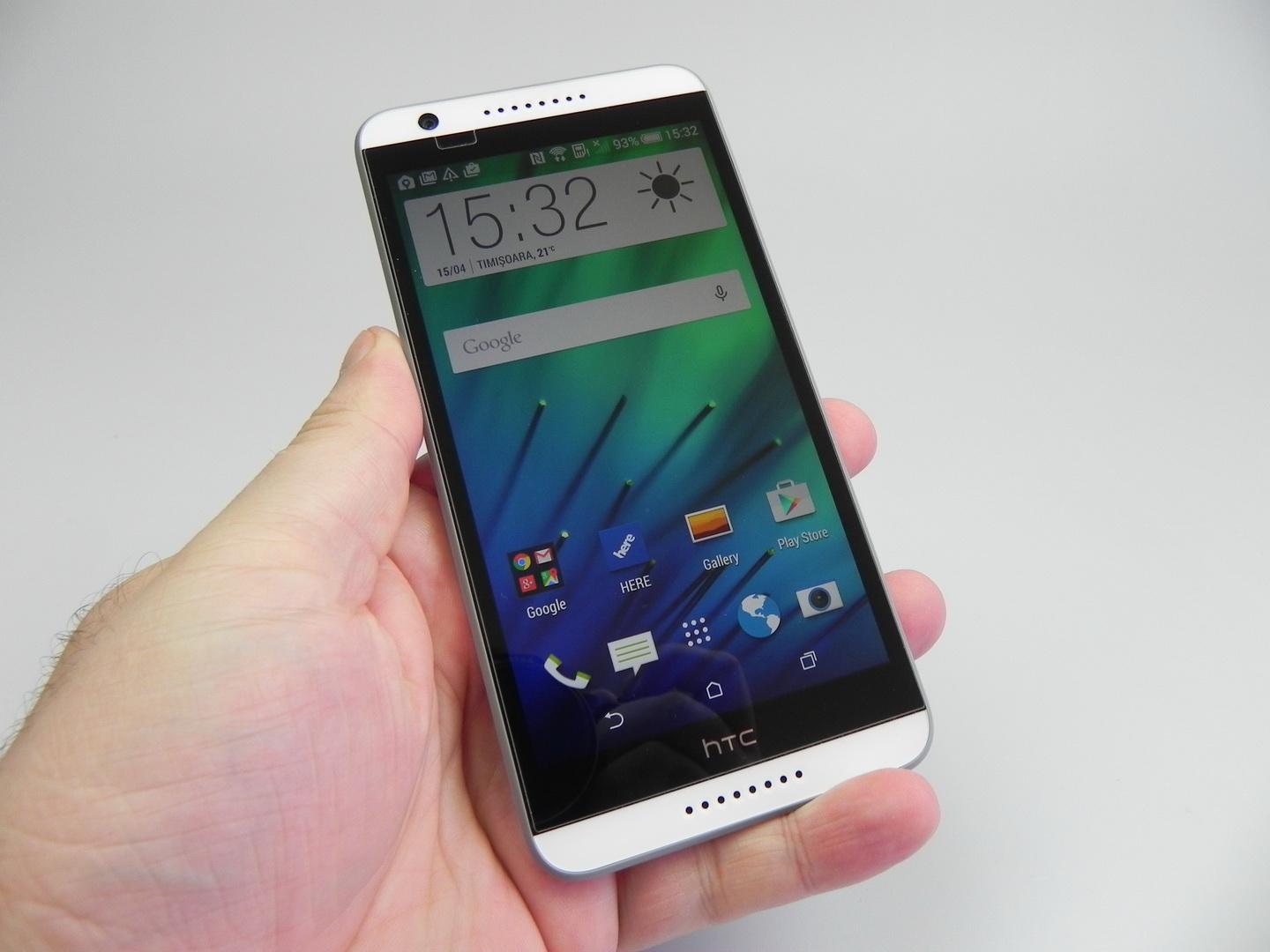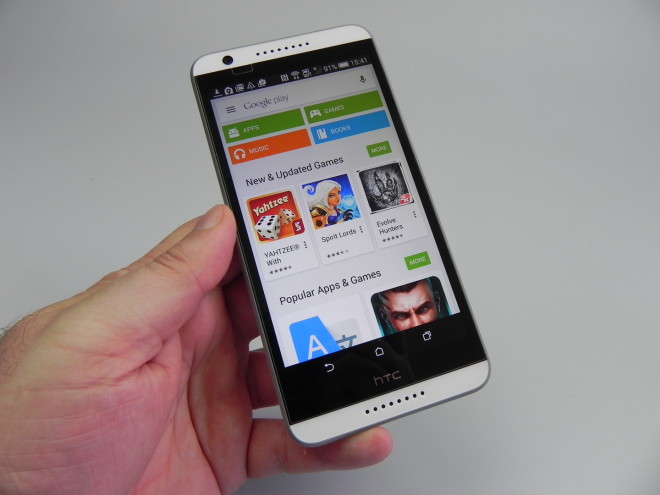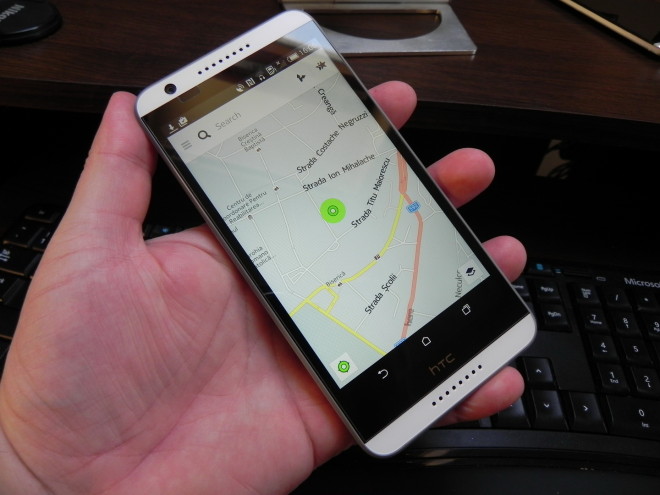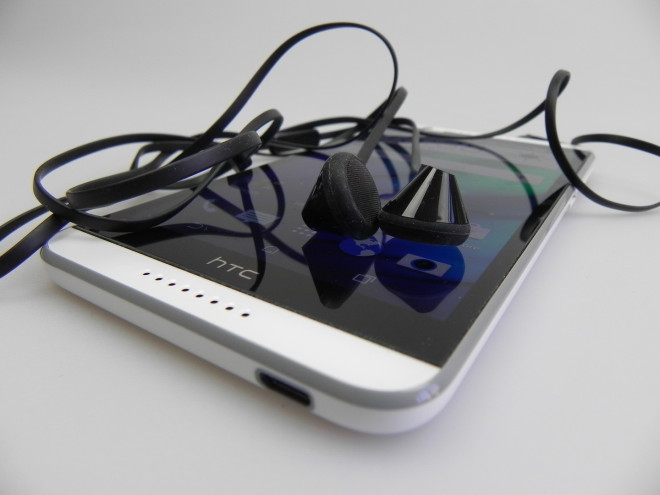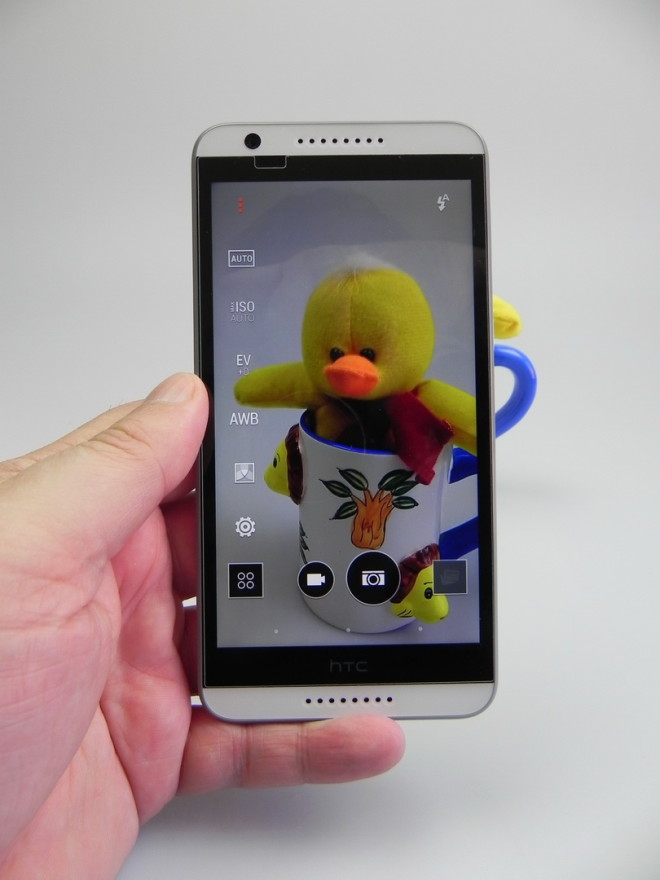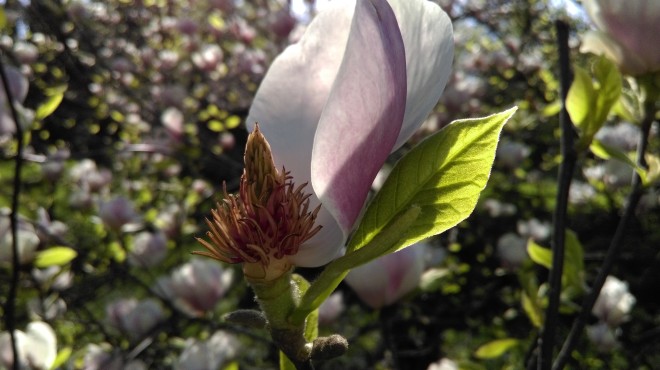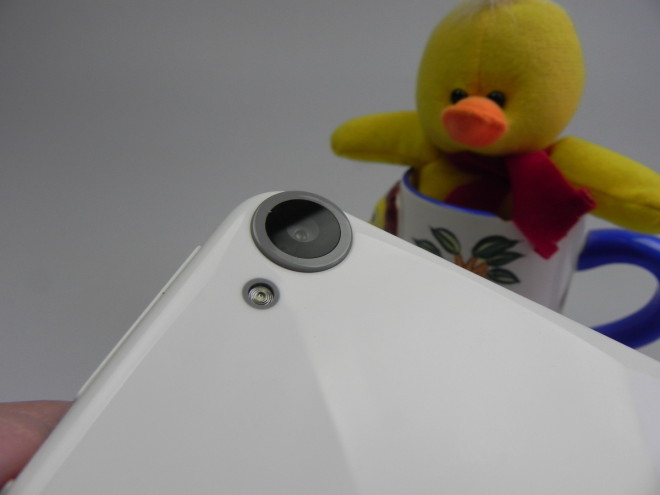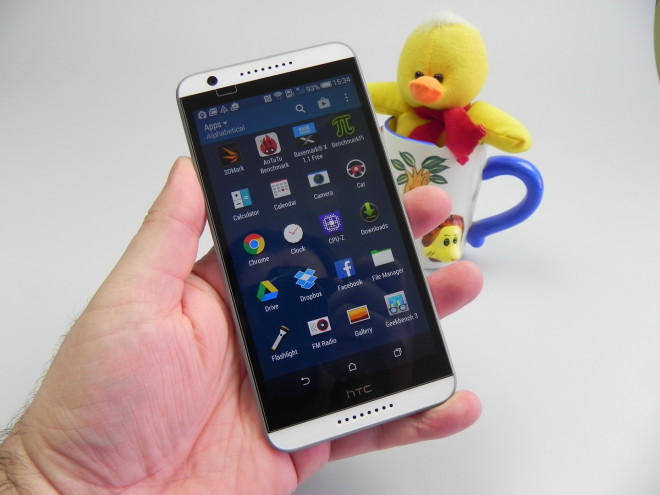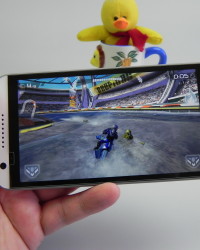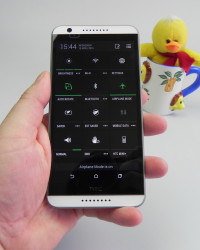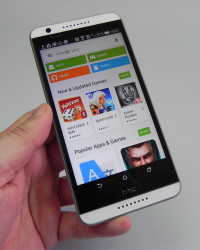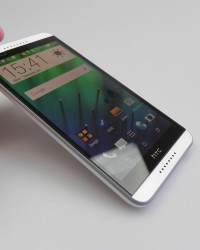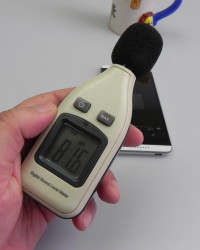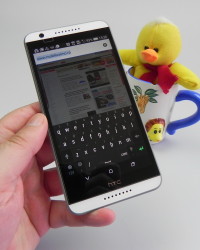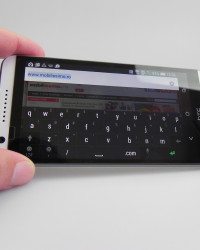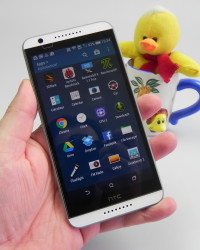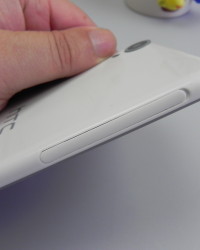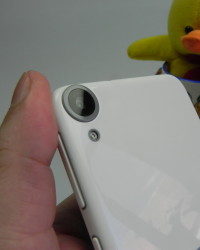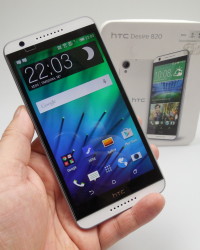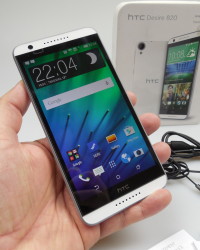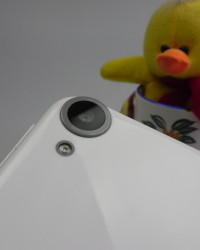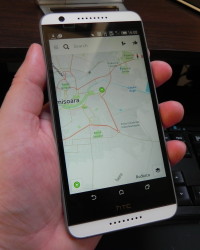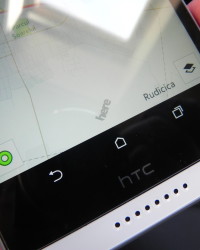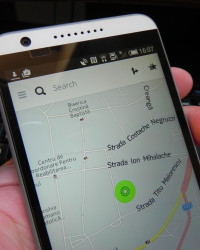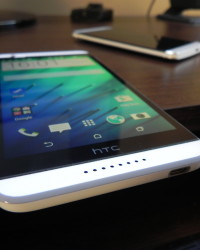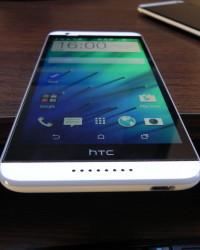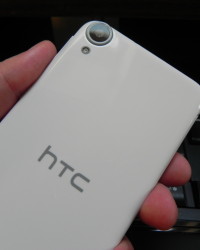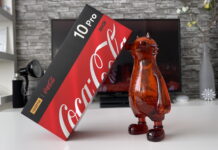HTC Desire 820 is a midrange phablet that was announced at IFA 2014 and finally came to us for testing purposes earlier this year. Thus, we proceeded to perform a full review of the device, shown in the video below. We were big fans of the Desire 816, so we had great expectations from this device.
The device is priced at $350 in USA and our version came in white and gray. The device uses a glossy plastic case, like the predecessor, but it’s not as slippery as one would expect. It’s still a very big machine, that makes one handed use kind of hard, but it’s a phablet after all, so that was expected. This model measures 7.7 mm in thickness, while the predecessor measured 7.9 mm, so that’s an evolution.
The weight is 155 grams, which is 10 grams lighter than the predecessor. We also get rounded corners and edges, big bezels and this device is a bit of a fingerprint magnet. Its frame feels solid and the Desire 820 is quite light, considering its width and even diagonal. Since it’s light and made of glossy plastic, it does tend to feel a bit like a toy and not a serious smartphone made of metal.
The front side hosts the camera and BoomSound speakers, as well as the sensors, while the notification LED is placed below the front camera. At the back there’s the main camera and flash, with the cam protruding a bit and being very easy coverable with the hand while taking pictures. At the top we find the audio jack and microphone, while at the bottom there’s the microUSB port.
On the left side there’s a lid, covering up the nano SIM card slot and the microSD card slot. On dual SIM models there will be two nano SIM slots here. On the right side there’s the On/Off button, accompanied by volume buttons, all of them with good feedback. The phone has gray highlights, which I don’t quite like, since they make the handset feel a bit cheap or… dirty.
The design is overall OK for a midrange phablet, especially since it’s light. The main drawback is the easily coverable camera. On the hardware side, there’s the 5.5 inch screen, with a 1280 x 720 pixel resolution and Gorilla Glass 3 protection. There’s an IPS LCD panel in the mix and the CPU of the phone is a Qualcomm Snapdragon 615, an octa core 64 bit unit. Other features include an Adreno 405 GPU, 16 GB of storage, a microSD card slot with support for up to 128 GB extra storage, 2 GB of RAM and a main 13 MP camera.
At the front we find an 8 MP selfie cam and connectivity options are the following: 4G LTE, WiFi dual band, WiFi Direct, DLNA, Bluetooth 4.0, GPS, Glonass, NFC, FM radio and microUSB 2.0. Desire 820 also offers an accelerometer, proximity sensor, ambient light sensor, stereo speakers and compass. Its battery is a Li-Po 2600 mAh unit, that on paper provides 424 hours of standby functioning, or 22 hours of talk time. In our test, that involves HD video playback with WiFi on and brightness at 50% we achieved a playback time of 7 hours and 13 minutes.
This is about 30 minutes less than the Desire 816, that had a similar 2600 mAh battery. We are below 2014 flagships with this time, but above the LG G3 for example, since that one scored 5 hours and 6 minutes of playback. With average use we got one day of functioning or even one day and a half. The PCMark test, that involves continuous usage simulation, with WiFi on and brightness at 200 LUX, we scored 5 hours and 25 minutes.
This is 10 minutes more than the OnePlus One and almost 20 minutes more than the LG G Flex 2. The charging takes 2 hours and 57 minutes, which is also pretty much OK, especially since it’s more than half an hour less than the Desire 816. Overall the battery is good and you also get a few of the usual HTC power saving options. We’ve got Power Saver, that conserves CPU power, reduces screen brightness and turns off vibration, plus it turns off data when the screen is off.
Then there’s Extreme Power Save, that shows a tile-based UI, with only the minimal features accessible, a dimmed screen and data off in standby mode. Another option is Sleep Mode, that manages to also turn off the data in long periods of inactivity. Finally, in the same Settings area we’ve got the Fast boot option. Now let’s discuss acoustics!
This phone comes with BoomSound stereo speakers and a simple music player, with a minimal UI and organization in artists, albums, songs and playlists. The Settings only include Album Art, Artist, Photos and Lyrics, with no trace of an equalizer. The experience offered by the phablet involves a cute visualizer, a crisp and loud experience, clear sound, good bass, warm sound and no noise whatsoever.
The high notes are also well output. The headphones that come with the device aren’t the same with the ones of the HTC One series models. We do get a comfy pair, with a flat wire that doesn’t tangle, a small remote and a very loud experience. The percussion is perfect here and guitar parts were heard great. When you’re using the headphones, you can also activate the BoomSound option from the Settings that increases surround quality, volume and bass.
Then there’s FM radio with the ability to find stations fast and we also did a decibelmeter test. In this test we achieved 81.6 dBA at the front of the smartphone and 79.3 dBA at the back. Those results were achieved with an audio test sample, but in gaming and movies we got to 84.4 dBA. This puts us above the iPhone 6 Plus and its 83.8 dBA, but also below the 85.4 dBA of the HTC Desire 816.
FLAC support is offered too, by the above mentioned player. Obviously we’re not on par with HTC One units, but also not bad for a midranger, not bad at all actually. The display included on the Desire 820 is a 5.5 incher, with a 1280 x 720 pixel resolution and an IPS LCD panel, with Gorilla Glass 3 protection, something that was lacking on the Desire 816. The contrast isn’t very good and sunlight behavior isn’t excellent here.
There’s no video player, so we had to resort to the gallery app, that offers support for AVI files, MP3, MKV, WMV, but there’s no support for subtitles. The viewing experience brings up an oversaturated panel and a slightly white-ish image. The screen is bright, the image is crisp, but the pixel density isn’t very high and that’s pretty easy to notice, if you’ve seen a Quad HD panel and a Full HD one before and compared them to a HD one.
The view angles are wide and blacks are not deep. The pixels are of the RGB Stripe kind and when we used the luxmeter we achieved a value of 393 LUX, which is good, especially since we beat the likes of the Xperia Z2 and LG G3, that scored a bit over 300 LUX last year. We also surpassed the HTC Desire 816, that stopped at 362 LUX. The Settings area offers options for the font style and size, 3 finger output and flash notifications.
Overall the Desire 820 has a good display and we move on to the camera. We’re dealing with a 13 megapixel main shooter here, with a BSI sensor and a 28 mm lens. There’s an F/2.2 aperture in the mix, a 4:3 sensor and this is basically the same camera as the one from the Desire 816. The front cam is an 8 MP unit, with BSI and an upgrade from the predecessor’s 5 MP shooter.
The UI is typical for HTC, with flash options on the left and the bottom part of the screen including the main photo and video options. You will be able to choose stuff like Auto, Slow Mo Video, Fast HD (720p 60 FPS video capture), Night, HDR, Panorama, Anti Shake, Manual, Portrait, Landscape, Backlight, Text and Macro. The manual mode opens up a series of sliders that allow you to tweak white balance, exposure, ISO up to 1600 and shutter and focus, too.
The options of the camera go on, with effects, crop (16:9/4:3/1:1), Make Up Level, Auto Smile Capture, Voice Capture, Touch to Capture, Lock Focus during Recording, Continuous Shooting, Review Duration, Self Timer and resolution (4224 x 2368 pixels in 16:9 or 4224 x 3136 in 4:3). There are also special tweaks for contrast, saturation, sharpness, video quality, grid, geotag, shutter sound and volume button options. Finally, on the right side there’s Gallery shortcut, shutter button and video capture button.
The main capture modes are Camera, Split Capture (front and back cam together), Photo Booth (a series of 4 shots with a few seconds between them) and Selfie. The latter brings its own settings, including a Beauty Slider, Auto, HDR, Portrait, Timer, Exposure, White Balance, Effects and Full HD filming. This model doesn’t offer a very fluid zoom and if you keep the screen pressed, you’ll lock exposure and focus. By the way, focus is slow and so is picture taking on this device.
The photo gallery we did was in a botanical garden, on a very sunny day and a lot of pictures were burnt. The greens were good and it was hard to focus for macros. In the shade the colors got better, but usually it was pretty easy to burn them. The level of detail is OK for a midranger and we pulled off some pretty crisp selfies. The selfie camera is excellent here, at a 2015 flagship level and offers good details and colors, plus a realistic skin color and texture.
After a bit of a struggle we triggered some nice macros of magnolia flowers, but that took some patience. The camera has a problem with red hues, burning them a lot, as well as yellows, at least in strong lighting. The HDR manages to exacerbate the burn sometimes, but in other times, like the picture of that statue, it tones down the temperature.
We also have a collection of cherry tree shots that were taken in the shade and look pretty fine. Overall, the pictures are clear, crisp, detailed and there’s a good panorama here, pretty wide and without artefacts. It has a resolution of 9440 x 896 pixels. Moving subjects are not easy to capture here and the night time shots brings forth a reasonably good flash and decent colors, when the lighting is on.
The camera can’t handle light sources like street lamps here, creating halos. The Desire 816 felt slightly better than the Desire 820 in the color department, managing to not burn pictures on a hot June day, while we did that on an April day… Aside from the burn issue, this sensor fits somewhere between the cameras of the Galaxy S4 and LG G2, as far as quality goes.
Now, as far as video capture goes, HTC Desire 820 records in MP4 format, with 30 FPS and in Full HD resolution. We’ve got a crisp first video, with an OK exposure change and a slightly burnt color. The videos have a 20 Mbps bitrate and stereo audio. The second video is a Fast HD capture one, with a cinematic look, feeling a bit like a documentary. It’s not very crisp, sadly. You can watch the videos here:
The third video is the one of a cat and it’s a bit burnt, as well as pixelated, when you zoom in. Stabilization is rather poor and then we did a slow mo capture, that wasn’t crisp, since the resolution wasn’t even 720p. There was also a video with good audio, cherry flowers represented OK on camera and with an OK exposure change. The last video was yet again a slow mo one, with two ducks flying around. The resolution is 768 x 432 pixels, which is rather poor.
At night, the filming is unimpressive, so it’s not worth mentioning. Overall, for a midrange phone, the HTC Desire 820 camera is pretty good, quality-wise, aside from the burnt pictures and videos. There were also a few out of focus pictures and some blur in the videos. HTC accustomed us with very good cameras even on midrange or lower end devices, so that’s the problem here.
Still, we do get a great selfie camera, as shown in the video review. Editing includes effects, filters, frames and tools, the usual ones. As far as temperature goes, we reached 42.2 degrees Celsius after playing 15 minutes of the game Riptide GP2, so the device gets a bit hot, but not where your hands are placed. The phone section brings speed dial, a large dial pad option, Internet calling, Smart dial and there’s a feature that makes the handset ring louder when it detects it’s in a pocket.
Calls are loud and clear and signal is good. And now let’s get to the benchmarks. We compared the HTC Desire 820 to the Desire 816, Galaxy Note 3 and Allview X2 Soul. This is a battle between the Snapdragon 615 CPU, the Snapdragon 400 quad core, Snapdragon 800 and a MediaTek octa core chipset. These are the results:
Desire 820 wins 8 out of the 11 battles in front of the Allview model and 11 out of 11 in front of the Desire 816. It’s also not very far from the Galaxy Note 3, which is quite a feat. There’s no lag obviously and the game Riptide GP2 runs without a hassle. This phablet runs Android 4.4.4, with HTC Sense 6.0 on top and BlinkFeed on the leftmost homescreen. It includes the usual social network and news feed, shown as tiles.
Multitasking is done showing 9 thumbnails and you swipe up to close apps. The web browser is fast and we’ve got a large keyboard, that’s pretty comfy and well spaced. Virtual Android buttons are also here and once you pinch the screen, you will trigger the typical widget area, with the trademark HTC widgets being black and white, sometimes also gray and green.
HTC Sense 6.0 involves a minimal UI, that’s simple and includes no gloss, plus it’s fluid and efficient. The dropdown area offers access to notifications and quick settings and shows them with big icons. And now here’s the preinstalled app list, that includes quite a bit of bloatware: Mail, Calendar, Maps, Zoe (now with social networking features), YouTube, Play Music, Play Books, Play Newsstand, Chrome, Gmail, Photos, Google+, Hangouts, News + Weather, Play Games, Facebook, Car Mode, Kid Mode, People, Scribble, Drive and Polaris Office.
Then there’s Tasks, Stocks, Calculator, Weather, Voice Recorder, File Manager, HTC Backup, HTC Dot view and HTC Power to Give, as well as Themes and Here Maps (not sure if preinstalled or not). Zoe allows you to create short clips made from your pictures and videos, with the filters and soundtrack of your choice, while Scribble lets you draw, doodle, hand write or insert stickers into a memo or birthday card.
HTC Power to Give associates a part of your device’s processing power to a project that researches various disease cures, or other major tasks. And now here’s the verdict we give for the HTC Desire 820.
These are the Pros:
comfy to use
OK battery
good speakers and good headphones
bright screen
good macro pictures
very good selfie camera
lots of camera options
runs new games with no problem
good benchmarks
good looking UI
And the Cons:
oversaturated display
poor sunlight behavior
burnt pictures
a bit underwhelming videos
bloatware
gray accents don’t look very well
HTC Desire 820 gets from us a 9 out of 10 for design, an 8.8 for hardware and a 9.3 for OS and UI. The final grade is 9.03 out of 10 and this one is a good selfie and gaming device, with a proper format for video watching, too. It’s comfy to hold and use, takes great selfie shots, but the back camera was a bit of a letdown. The price is also pretty good and so are the acoustics.

